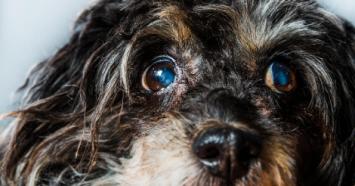
Today we have a guest post from Dr Jennifer Coate, an associate of Dr Rex Riggs who has regularly guest posted on the Embrace blog.
Dr Coate talks about what causes a dog's eyes to turn cloudy or gray and if it is something to be concerned about or not.
Many times our clients notice their older pet’s eyes are starting to have a bluish-gray haze and they assume that their old dog is going blind. But what is really happening in the eye?
The pupil of the eye is normally black. What you are seeing in the pupil is the lens, which lies just behind the pupil. Just like in a camera or eye glasses, the lens is a clear structure used to focus images as they pass into the eye to your pet’s retina.
Today, I am only discussing diseases that cause the lens to look cloudy, gray, hazy, or even white. If the surface or any of the front chamber of the eye looks cloudy, or if the eye is red, having discharge, or bothering the dog you should have it checked by a veterinarian immediately.
Common Causes of Cloudy Eyes in Dogs
There are 2 main things that will cause your pet’s lens to look cloudy- cataracts and lenticular nuclear sclerosis.
Lenticular Nuclear Sclerosis in Dogs
Despite its long name, lenticular nuclear sclerosis (often referred to as lenticular sclerosis or nuclear sclerosis) is simply a normal aging change of the lens. The lens is made up of fibers that get denser as the animal ages. Nuclear sclerosis occurs when the fibers in the center of the lens become so dense that it appears cloudy. This happens in every aging pet - - as early as 6 years of age in the dogs and 9 years of age in the cat. This change rarely affects the vision of the pet beyond a mild decrease in their ability to focus on close up items, especially in dim lighting. The vision change is almost never noticed by the pet owner and there is no need to treat lenticular sclerosis.
Lenticular Sclerosis vs Cataracts
A cataract on the other hand is any opacity of the lens that prevents light from passing through the lens to the retina. Cataracts can involve a small portion of the lens causing the pet to have a blind spot, or be more severe involving the entire lens causing the eye to be blind.
Hereditary Cataracts in Dogs
There are many causes linked to cataracts. The most common cause of cataracts in dogs is a genetic predisposition - they were born with a tendency to develop cataracts at some point in life. Hereditary cataracts occur in many dog breeds including miniature poodles, cocker spaniels, miniature schnauzers, golden retrievers, Boston terriers, and Siberian huskies. Hereditary cataracts have also been reported in Persian, Himalayan, and Birman cats, although in cats they are usually born with the cataract.
Other causes of cataracts include age related formation, congenital (born with it), inflammation of the eye, diets, toxins, trauma, and diabetes. Most diabetic dogs, although not diabetic cats, will develop cataracts. In fact, I have diagnosed diabetes in several patients after the astute owners noticed that their dog’s eyes suddenly looked hazy.
Besides causing blindness, cataracts can cause other problems with the eye. A lens with cataracts can fall out of place causing pain, inflammation, and even glaucoma, an increase in the pressure of the eye that can be very painful and can permanently damage the eye. A cataract can also become so severe the lens will leak which can then cause severe inflammation within the eye (uveitis) and glaucoma.
If you notice any changes in your pet’s eyes or vision, you should have them evaluated by a veterinarian. Your veterinarian can look to see if it is truly the lens verses other portions of the eye that are affected. They can usually differentiate between lenticular sclerosis and cataracts during a physical exam using an ophthalmoscope. In some cases, they may need to dilate the pupil to better visualize the lens or do other tests. This may include checking eye pressure to check for uveitis or glaucoma or doing blood work to look for disease such as diabetes.
If your pet is found to have cataracts, your veterinarian can discuss with you the best treatment options. If an underlying cause is found, such as diabetes, initially treatment will be geared towards correcting that. Many dogs can live happily with the decreased vision form cataracts, even blindness and will need no treatment. If the cataract is causing problems, or if you wish to preserve vision, your pet can be referred to an ophthalmologist to have surgery to replace the lens with a prosthetic lens.
Dr. Jennifer Coate grew up in Celina, Ohio and received her DVM from Ohio State University. She has performed research at the James Cancer Research Institute, Duke University Medical Center, and the OSU College of Veterinary Medicine in areas ranging from cancer gene expression to creating a molecular model for the FIV virus. Dr. Coate has been the surgeon for the non-profit animal shelter, Citizens for Humane Action, spaying and neutering rescued animals for adoption. She joined the Best Friends staff in the summer of 2008.
Dr. Coate lives with her husband, Matt, in Hilliard. They have a very energetic Jack Russel-Beagle Mix named Mitchell and two cats, Dusty & George. Dr. Coate spends most of her free time renovating her house. She also enjoys long walks with Mitchell.